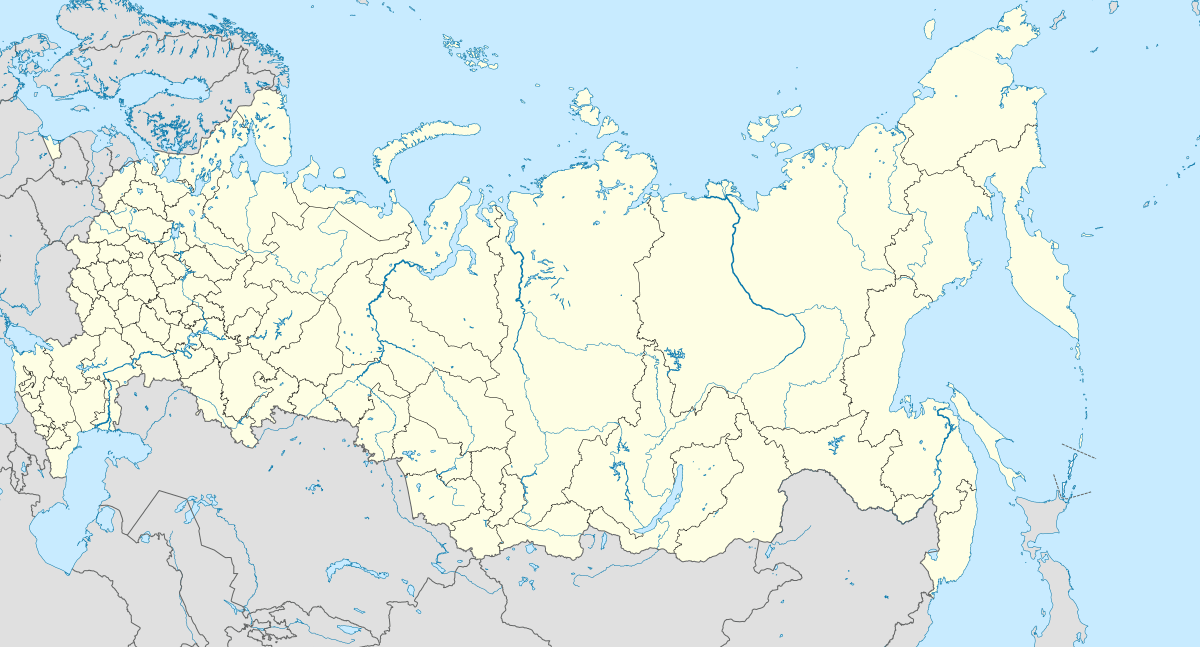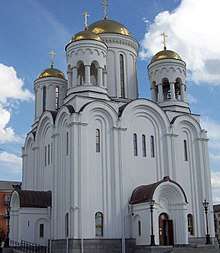Serov (town)
Serov (Russian: Серо́в) is a mining and commercial town in Sverdlovsk Oblast, Russia, located on the eastern foothills of the Ural Mountains, on the left bank of the Kakva River (a tributary of the Sosva), about 350 kilometers (220 mi) north of Yekaterinburg. Population: 99,373 (2010 Census);[2] 99,804 (2002 Census);[8] 104,158 (1989 Census).[9]
Serov Серов | |
|---|---|
Town[1] | |
.png) Flag .png) Coat of arms | |
Location of Serov %26groups%3D_7583bafe957fac38dad2c6784110b7bfd6a6e43a.svg)
| |
 Serov Location of Serov  Serov Serov (Sverdlovsk Oblast) | |
| Coordinates: 59°36′N 60°34′E | |
| Country | Russia |
| Federal subject | Sverdlovsk Oblast[1] |
| Founded | 1893 |
| Town status since | 1926 |
| Government | |
| • Mayor | Vladimir Anisimov |
| Elevation | 105 m (344 ft) |
| Population | |
| • Total | 99,373 |
| • Estimate (2018)[3] | 97,366 (-2%) |
| • Rank | 167th in 2010 |
| • Subordinated to | Town of Serov[4] |
| • Capital of | Serovsky District[1], Town of Serov |
| • Urban okrug | Serovsky Urban Okrug[5] |
| • Capital of | Serovsky Urban Okrug |
| Time zone | UTC+5 (MSK+2 |
| Postal code(s)[7] | 624XXX |
| Dialing code(s) | +7 34385 |
| OKTMO ID | 65756000001 |
| Website | www |
History
Archaeological evidence suggests that the Mansi or their ancestors populated the area of Serov as early as 1000 BCE. In the early days of the Russian colonization of Siberia the district had only a few minor villages. The situation changed in 1893, when the chief manager of Bogoslovsk Mining District, Alexander Auerbakh, proposed a construction of a cast iron and rail plant on the Kakva River near the end of an existing railroad. This year the construction of a workers' settlement began. It was named Nadezhdinsk after Nadezhda Polovtsova, the owner of Bogoslovsk Mining District.[10] The first steel and rails in Nadezhdinsk were produced in 1896. Nadezhdinsk became an important supplier of rails for the Trans-Siberian Railway. Dmitry Mendeleyev, who visited Nadezhdinsk, was pleasantly surprised by the progressive technology used at the plant. The first school in Nadezhdinsk opened in December 1895, the first power plant (415 kW) in 1907.
The Revolution of 1905 affected Nadezhdinsk, with the turmoil continuing through 1908. At the beginning of World War I, Nadezhdinsk industry was reshaped[11] to meet the demands of the military. Klein Brothers machine-building factory relocated to Nadezhdinsk from Riga in 1917. The growing demand for workforce was met by hiring workers from China and Korea, as well as prisoners of war (POWs). There were 1,266 Chinese and Koreans, and 3,329 POWs in Nadezhdinsk in 1917.
On October 27, 1917, two days after the October Revolution in Petrograd, power in the town bloodlessly transferred to the Worker's Soviet. On December 18, 1917, Bogoslovsk Mining District, including the Nadezhdinsk plants, was nationalized. In October 1918, the army of the Provisional Government of Siberia, which opposed the Soviets in the Russian Civil War, occupied Nadezhdinsk. On November 20, 1918, two days after admiral Kolchak become the head of the White government of Siberia, the "whites" in Nadezhdinsk executed twenty-three of their "red" opponents. On July 19, 1919, Red partisans, supporting the Soviets, re-took the settlement. It was devastated after the Civil War. None of the factories were working and many engineers left the area.
15 September 1919 Nadezhdinsk gained town status. The Central Executive Committee decree of 5 April 1926 Nadezhdinsk was approved within the cities of the Ural region.[12]
The Soviet government put a lot of effort into restoring normal life and economy. By the end of 1925, Nadezhdinsk plant was running at its full capacity. Streets and house numbers were changed. A hospital, a circus, and a cabaret opened.
In the 1930s ferrous-metal production in Nadezhdinsk expanded and diversified. In 1934 the town was renamed Kabakovsk, after Ivan Dmitrievich Kabakov, the leader of the Bolshevik Party in Sverdlovsk Oblast. In 1937, Kabakov was dismissed and executed in Stalin's purges, and the town's name changed back to Nadezhdinsk. On 7 June 1939 the town was renamed Serov, after the fighter-pilot Anatoly Serov, a former Nadezhdinsk Plant worker and a hero of the Spanish Civil War, who had died on 11 May 1939.[13]
Serov was an important center of steel production during World War II. Due to the shortage of males, who were conscripted into active service, most steel jobs were taken by women. Numerous organizations evacuated to Serov from the Soviet territories occupied by Germans: hospitals from Polotsk and Smolensk, and Lenkom Theater from Leningrad.
After the war, demand for steel increased even more due to reconstruction. Serov became a major electrified railroad center and a new power plant was built. In 1958, Serov produced its first ferrosilicon. In the 1970s a timber factory and a gas pipeline were built.
In the early 1990s the failed reforms of Mikhail Gorbachev brought the town economy to a record low level. The town saw a significant growth of unemployment and poverty, as did most other small towns in Russia. At the same time, many businesses were privatized or became municipal property.
On July 14, 1993, a dam at Kiselevskoye water reservoir broke and 1,373 families lost their houses.
Since the 2000s, the town economy has improved, the standards of living have risen, and the town appearance continues to improve. In November 2004, Serov hosted the Russian Bodybuilding and Fitness Championship.
Administrative and municipal status
Within the framework of the administrative divisions, Serov serves as the administrative center of Serovsky District,[1] even though it is not a part of it.[4] As an administrative division, it is, together with thirty-six rural localities, incorporated separately as the Town of Serov[4]—an administrative unit with the status equal to that of the districts.[14] As a municipal division, the Town of Serov is incorporated as Serovsky Urban Okrug.[5]
Economy
Serov is a major center of ferrous metallurgy, which constitutes 80% of its economy. Two largest companies are A. K. Serov Metallurgical Plant and Serov Ferro-Alloys Plant. The latter produces approximately 5% of the world's ferrochromium. Other industries are machine-building, timber, food. Serov Power Plant (Serovskaya GRES) provides electricity to the area. The town is the center of a mining area, with lignite, iron, bauxite, and gold mines.
Climate
The climate is continental, with temperate summers and cold snowy winters.
Notable people
- Anton Bakov, politician and entrepreneur
- Gennadiy Seleznyov, politician
- Kostya Tszyu, boxer
References

Notes
- Государственный комитет Российской Федерации по статистике. Комитет Российской Федерации по стандартизации, метрологии и сертификации. №ОК 019-95 1 января 1997 г. «Общероссийский классификатор объектов административно-территориального деления. Код 65 238», в ред. изменения №278/2015 от 1 января 2016 г.. (State Statistics Committee of the Russian Federation. Committee of the Russian Federation on Standardization, Metrology, and Certification. #OK 019-95 January 1, 1997 Russian Classification of Objects of Administrative Division (OKATO). Code 65 238, as amended by the Amendment #278/2015 of January 1, 2016. ).
- Russian Federal State Statistics Service (2011). "Всероссийская перепись населения 2010 года. Том 1" [2010 All-Russian Population Census, vol. 1]. Всероссийская перепись населения 2010 года [2010 All-Russia Population Census] (in Russian). Federal State Statistics Service.
- "26. Численность постоянного населения Российской Федерации по муниципальным образованиям на 1 января 2018 года". Federal State Statistics Service. Retrieved January 23, 2019.
- Государственный комитет Российской Федерации по статистике. Комитет Российской Федерации по стандартизации, метрологии и сертификации. №ОК 019-95 1 января 1997 г. «Общероссийский классификатор объектов административно-территориального деления. Код 65 492», в ред. изменения №278/2015 от 1 января 2016 г.. (State Statistics Committee of the Russian Federation. Committee of the Russian Federation on Standardization, Metrology, and Certification. #OK 019-95 January 1, 1997 Russian Classification of Objects of Administrative Division (OKATO). Code 65 492, as amended by the Amendment #278/2015 of January 1, 2016. ).
- Law #85-OZ
- "Об исчислении времени". Официальный интернет-портал правовой информации (in Russian). June 3, 2011. Retrieved January 19, 2019.
- Почта России. Информационно-вычислительный центр ОАСУ РПО. (Russian Post). Поиск объектов почтовой связи (Postal Objects Search) (in Russian)
- Russian Federal State Statistics Service (May 21, 2004). "Численность населения России, субъектов Российской Федерации в составе федеральных округов, районов, городских поселений, сельских населённых пунктов – районных центров и сельских населённых пунктов с населением 3 тысячи и более человек" [Population of Russia, Its Federal Districts, Federal Subjects, Districts, Urban Localities, Rural Localities—Administrative Centers, and Rural Localities with Population of Over 3,000] (XLS). Всероссийская перепись населения 2002 года [All-Russia Population Census of 2002] (in Russian).
- "Всесоюзная перепись населения 1989 г. Численность наличного населения союзных и автономных республик, автономных областей и округов, краёв, областей, районов, городских поселений и сёл-райцентров" [All Union Population Census of 1989: Present Population of Union and Autonomous Republics, Autonomous Oblasts and Okrugs, Krais, Oblasts, Districts, Urban Settlements, and Villages Serving as District Administrative Centers]. Всесоюзная перепись населения 1989 года [All-Union Population Census of 1989] (in Russian). Институт демографии Национального исследовательского университета: Высшая школа экономики [Institute of Demography at the National Research University: Higher School of Economics]. 1989 – via Demoscope Weekly.
- Дзюбинский Л. И. Свет над тайгой. Очерки по истории Металлургического завода имени А. К. Серова. — Екатеринбург: «Уральское издательство», 2002.
- October 27, 1915 between the main artillery Directorate and the Chairman of the Theological mountain district state Councilor A.A. Polovtsov signed a contract for the supply of high-explosive bombs to howitzers.
- Города Среднего Урала: Прошлое, настоящее, будущее / Е. Анимица; Науч. ред. И. В. Комар. — 2-е изд., перераб., доп. – Свердловск : Сред.-Урал. кн. изд-во, 1983. – С. 166, – 287 с.
- Дзюбинский Л. И. Три имени города. — Екатеринбург: Средне-Уральское книжное издательство, 1999. — 192 с.
- Law #30-OZ
Sources
- Областная Дума Законодательного Собрания Свердловской области. Областной закон №30-ОЗ от 20 мая 1997 г. «Об административно-территориальном устройстве Свердловской области», в ред. Закона №32-ОЗ от 25 апреля 2012 г. «О внесении изменений в Областной закон "Об административно-территориальном устройстве Свердловской области"». Вступил в силу со дня официального опубликования за исключением отдельных положений, вступающих в силу в иные сроки. Опубликован: "Областная газета", №81, 3 июня 1997 г. (Oblast Duma of the Legislative Assembly of Sverdlovsk Oblast. Oblast Law #30-OZ of May 20, 1997 On the Administrative-Territorial Structure of Sverdlovsk Oblast, as amended by the Law #32-OZ of April 25, 2012 On Amending the Oblast Law "On the Administrative-Territorial Structure of Sverdlovsk Oblast". Effective as of the day of the official publication with the exception of several clauses which take effect on a different date.).
- Областная Дума Законодательного Собрания Свердловской области. Закон №85-ОЗ от 12 июля 2007 г. «О границах муниципальных образований, расположенных на территории Свердловской области», в ред. Закона №107-ОЗ от 29 октября 2013 г. «Об упразднении отдельных населённых пунктов, расположенных на территории города Ивделя, и о внесении изменений в Приложение 39 к Закону Свердловской области "О границах муниципальных образований, расположенных на территории Свердловской области"». Вступил в силу через 10 дней после официального опубликования. Опубликован: "Областная газета", №232–249, 17 июля 2007 г. (Oblast Duma of the Legislative Assembly of Sverdlovsk Oblast. Law #85-OZ of July 12, 2007 On the Borders of the Municipal Formations on the Territory of Sverdlovsk Oblast, as amended by the Law #107-OZ of October 29, 2013 On Abolishing Several Inhabited Localities on the Territory of the Town of Ivdul and on Amending the Law of Sverdlovsk Oblast "On the Borders of the Municipal Formations on the Territory of Sverdlovsk Oblast". Effective as of the day which is 10 days after the official publication.).
External links
- Official website of Serovsky Urban Okrug (in Russian)
- Official website of the A. K. Serov Metallurgical Plant (in English and Russian)
- Official website of the Serov Ferro-alloys Plant (in Russian)